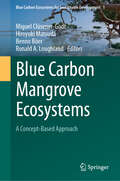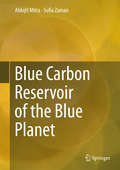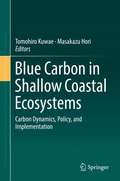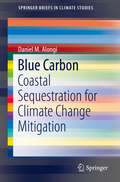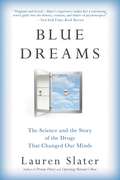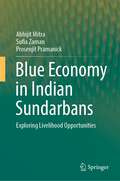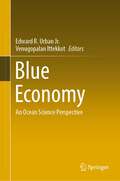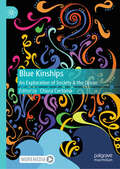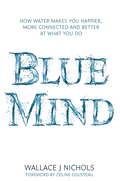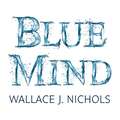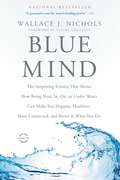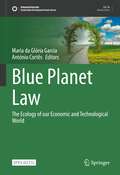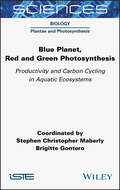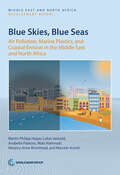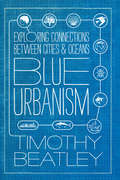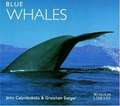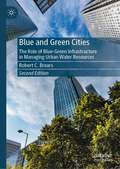- Table View
- List View
Blue Carbon Mangrove Ecosystems: A Concept-Based Approach (Blue Carbon Ecosystems for Sustainable Development #1)
by Benno Böer Miguel Clüsener-Godt Hiroyuki Matsuda Ronald A. LoughlandBlue carbon ecosystems are of tremendous value toward the utilization of high-salinity water, such as seawater, as well as hyper-saline soils, and salt-tolerant biota for the production of biomass, for food, feed, fiber, fuel, other economic purposes, and carbon sequestration. In order to achieve the 17 SDGs, the scientific research into blue carbon ecosystems is an absolutely important element. Moreover, monitoring is needed, as well as the conservation of the remaining blue carbon ecosystems, and the restoration of lost habitat. The book will provide comprehensive scientific documentation inspiring the way forward on how to utilize saline resources in the best interest of humanity. It will try to foster the academic research and networking for land-users, politicians, development banks, innovative farmers, investors, energy- producers, and carbon-off-setters. The papers presented in this book emanate from a conference held at the Yokohama National University (Japan) in January 2023.
Blue Carbon Reservoir of the Blue Planet
by Abhijit Mitra Sufia ZamanThe ever increasing emission of carbon dioxide due to rapid industrialization, urbanization, unplanned tourism and alteration of land use pattern is causing unprecedented changes to marine biodiversity. Irrespective of political philosophy, nation, caste, sex and religion, mankind is under the appalling shadow of climate change. Today nature-based approaches for the mitigation of climate change are increasingly accepted as part of the low-cost solution. Thrust has been given by several scientific communities to assess the magnitude and viability of carbon sequestering potential of plants. Coastal producer communities like mangroves, salt marsh grass, seagrass beds, and seaweeds absorb atmospheric carbon dioxide during the process of photosynthesis. This carbon known as the 'blue carbon' is thus associated with the marine and estuarine ecosystems. However, a number of gaps in our scientific knowledge on blue carbon domain still exist. Molluscs, coral reefs, phytoplankton, which are amongst the important storehouses of carbon, have not been addressed. Very few scientific studies on the carbon stored in these valuable natural vaults have been performed, and no data bank is available on their carbon sequestering capacity on global basis. The methodologies for assessing blue carbon stock also need further standardization so that credit from blue carbon reservoir is accepted by the International bodies in the form of a concrete policy. It is a matter of great appreciation that Conservation International (CI), the International Union for Conservation of Natural Resources (IUCN), and the Intergovernmental Oceanic Commission (IOC) of UNESCO is collaborating with governments, research institutions, non-governmental and international organizations, and communities around the world to develop management approaches, financial incentives and policy mechanisms for ensuring conservation and restoration of blue carbon ecosystems and implement projects around the world that demonstrate the feasibility of blue carbon accounting, management, and incentive agreements. The present book has critically presented the data bank for each community of blue carbon not merely in the form of text description, but also through case studies that are the outcomes of research projects and pilot programmes.
Blue Carbon in Shallow Coastal Ecosystems: Carbon Dynamics, Policy, And Implementation
by Tomohiro Kuwae Masakazu HoriThis book presents a comprehensive and innovative understanding of the role of shallow coastal ecosystems in carbon cycling, particularly marine carbon sequestration. Incorporating a series of forward-looking chapters, the book combines thorough reviews of the global literature and regional assessments—mainly around the Indo-Pacific region and Japan—with global perspectives to provide a thorough assessment of carbon cycling in shallow coastal systems. It advocates the expansion of blue-carbon ecosystems (mangroves, seagrass meadows, and salt marshes) into macroalgal beds, tidal flats, coral reefs, and urbanized shallow waters, demonstrating the potential of these ecosystems as new carbon sinks. Moreover, it discusses not only topics that are currently the focus of blue-carbon studies, i.e., sedimentary carbon stock and accumulation rate, but also CO2 gas exchange between the atmosphere and shallow coastal ecosystems, carbon storage in the water column as refractory organic carbon, and off-site carbon storage. Including highly original contributions, this comprehensive work inspires research beyond the specific regions covered by the chapters. The suite of new concepts and approaches is refreshing and demonstrates that blue-carbon research is indeed a vibrant new field of research, providing deep insights into neglected aspects of carbon cycling in the marine environment. At the same time the book provides guidance for policy makers to deliver benefits to society, for example the inclusion of blue carbon as a carbon offset scheme or the Nationally Determined Contribution (NDC) in the Paris Agreement, and also for building resilience in coastal socio-ecosystems through better management. This book is intended for all those interested in the science and management of coastal ecosystems.
Blue Carbon: Coastal Sequestration for Climate Change Mitigation (SpringerBriefs in Climate Studies)
by Daniel M. AlongiThis work summarizes the science and management of a rapidly expanding topic in climate science, namely adaptation and mitigation. The term 'blue carbon' refers to the rates, pathways and volumes of greenhouse carbon sequestered in coastal estuarine and marine ecosystems such as salt marshes, mangroves and seagrass meadows. Blue carbon and its vital role in climate change mitigation are central to this book.Readers find summaries and analysis of both the basic scientific data and data from blue carbon field projects, and a practical guide on how to manage a successful blue carbon field project. There is a discussion on how to maximize the carbon sequestration and consideration of whether blue carbon projects make a difference.The work is not only of interest to scholars involved in climate science, but also those in the marine sciences, and those in ecosystem ecology, biogeochemistry; geochemistry; estuarine and marine plant ecology.
Blue Dreams: The Science and the Story of the Drugs that Changed Our Minds
by Lauren SlaterA groundbreaking and revelatory history of psychotropic drugs, from "a thoroughly exhilarating and entertaining writer" (Washington Post). Although one in five Americans now takes at least one psychotropic drug, the fact remains that nearly seventy years after doctors first began prescribing them, not even their creators understand exactly how or why these drugs work--or don't work--on what ails our brains. Blue Dreams offers the explosive story of the discovery and development of psychiatric medications, as well as the science and the people behind their invention, told by a riveting writer and psychologist who shares her own experience with the highs and lows of psychiatric drugs. Lauren Slater's revelatory account charts psychiatry's journey from its earliest drugs, Thorazine and lithium, up through Prozac and other major antidepressants of the present. Blue Dreams also chronicles experimental treatments involving Ecstasy, magic mushrooms, the most cutting-edge memory drugs, placebos, and even neural implants. In her thorough analysis of each treatment, Slater asks three fundamental questions: how was the drug born, how does it work (or fail to work), and what does it reveal about the ailments it is meant to treat?Fearlessly weaving her own intimate experiences into comprehensive and wide-ranging research, Slater narrates a personal history of psychiatry itself. In the process, her powerful and groundbreaking exploration casts modern psychiatry's ubiquitous wonder drugs in a new light, revealing their ability to heal us or hurt us, and proving an indispensable resource not only for those with a psychotropic prescription but for anyone who hopes to understand the limits of what we know about the human brain and the possibilities for future treatments.
Blue Economy in Indian Sundarbans: Exploring Livelihood Opportunities
by Abhijit Mitra Sufia Zaman Prosenjit PramanickThis book provides a cross-sectoral, multidisciplinary assessment of the major verticals of Blue Economy relevant to the mangrove ecosystem in Indian Sundarbans, which is a deltaic complex at the apex of Bay of Bengal. This book evaluates the feasibility of Blue Economy considering the natural resource base in this mangrove dominated deltaic complex.Chapter 1 discusses the need of expanding different marine and estuarine oriented verticals of Blue Economy as the land resources are gradually becoming depleted. Chapter 2 highlights the wide spectrum of biotic and abiotic resources of the Indian Sundarbans which can serve as the strong foundation of expanding Blue Economy in the region. Chapter 3 highlights several mangrove based livelihoods that are not only innovative, but may present new opportunities to initiate cottage industries. Chapter 4 highlights the threats associated with Blue Economy in Indian Sundarbans like, sea level rise, acidification of water, weather extremes, pollution, over-exploitation of natural resources, etc., along with ground-zero environmental data collated over three decades. Chapter 5 offers several solutions to combat the threats to regional Blue Economy emphasizing both technology and policy based management. The book attempts to align the proliferation of different sectors of Blue Economy in the framework of Indian Sundarbans.
Blue Economy: An Ocean Science Perspective
by Venugopalan Ittekkot Edward R. Urban Jr.The ocean is a major source of income for many coastal nations, particularly in the developing world. Economic benefits from the ocean in the long-term depend on its wise science and technology-based management. The intersection of science, technology, and economy are most obvious in nations' coastal zones. This book highlights the need for the application of ocean science and technology for best economic outcomes. It gives examples of ocean resources and the threats to them from climate change and other human interventions, as well as provides information on the available ocean research and observation tools to monitor their impact as well as on the related internationally available opportunities for capacity development.
Blue Extinction in Literature, Art, and Culture (Palgrave Studies in Animals and Literature)
by Rachel Murray Vera FibisanBlue Extinction in Literature, Culture, and Art examines literary and cultural representations of aquatic biodiversity loss, bringing together critical perspectives from the blue humanities and extinction studies. It demonstrates the affordances, as well as the limitations, of literary and artistic forms in exposing the plight of aquatic organisms, drawing attention to the social, political, and economic structures that are contributing to their destruction. Together, the essays in this collection demonstrate how literature and art can challenge dominant cultural conceptions and lingering misconceptions surrounding aquatic biodiversity loss, offering new ways of relating to species ranging from whales to oysters.
Blue Future: Protecting Water for People and the Planet Forever
by Maude BarlowSelected for The Globe 100 Books in 2013. The final book in Maude Barlow’s Blue trilogy, Blue Future is a powerful, penetrating, and timely look at the global water crisis — and what we can do to prevent it. The global water crisis has dramatically deepened. The stage is being set for drought on an unprecedented scale, mass starvation, and the migration of millions of refugees leaving parched lands in search of water. The story does not need to end in tragedy. In Blue Future, international bestselling author Maude Barlow offers solutions to the global water crisis based on four simple principles. Principle One: Water Is a Human Right chronicles the long fight to have the human right to water recognized and the powerful players still impeding this progress. Principle Two: Water Is a Common Heritage and Public Trust argues that water must not become a commodity to be bought and sold on the open market. Principle Three: Water Has Rights Too makes the case for the protection of source water and the need to make our human laws compatible with those of nature. Principle Four: Water Will Teach Us How to Live Together urges us to come together around a common threat — the end of water — and find a way to live more lightly on this planet. The final instalment in Barlow’s Blue trilogy, Blue Future includes inspiring stories of struggle and resistance from marginalized communities, as well as examples of government policies that work for people and the planet. A call to action to create a water-secure world, it is, in the end, a book of hope.
Blue Justice: Small-Scale Fisheries in a Sustainable Ocean Economy (MARE Publication Series #26)
by Svein Jentoft Ratana Chuenpagdee Alicia Bugeja-Said Moenieba IsaacsFor small-scale fisheries around the world, the Blue Growth and Blue Economy initiatives may provide sustainable development, but only insofar as they align with the global consensus enshrined in the Voluntary Guidelines for Securing Sustainable Small-Scale Fisheries in the context of Food Security and Poverty Eradication. If states do nothing to fulfill the promises they made when they endorsed these guidelines in 2014, the Blue Economy will come at a loss for small-scale fisheries and further their marginalization in the ocean economy. Under the umbrella of Blue Justice, this book demonstrates that these risks are real and must be considered as states implement their sustainable ocean development plans. These are human rights issues, which are embedded into governance principles and institutions and which make a difference for small-scale fisheries people in their daily lives. In stressing the importance of policies and institutions that build on the experiences of small-scale fisheries people in the contexts in which they operate, this book draws on case studies of small-scale fisheries from countries on all continents to clarify what Blue Justice entails for small-scale fisheries and make suggestions for real change. “Through the Blue Justice paradigm, this book flags the relevance of recognizing the potential impact that different factors, including the Blue Economy approach, could bring to fishing communities, their livelihoods, cultural traditions, and other potential multidimensional conflicts. Vulnerability in fishing communities can increase and inequalities can be reinforced at different levels if individuals and community capabilities are not strengthened… A first of its kind, not to be missed, this book is informative, purposeful, and pertinent in an era of change”. Silvia Salas, CINVESTAV, Marine Resources Department, Mérida, Mexico "The studies reveal that Blue Justice is a ‘governability’ issue, which requires establishing ‘right’ institutions, that are transdisciplinary (integrated), participatory, and holistic. It is implicit from these writings that the SSF Guidelines and Blue Growth initiatives do not form two different discourses, and that the implementation of the former would resolve many of the justice issues caused by the latter, in favor of small-scale fisheries and their communities". Oscar Amarasinghe, Professor & Chancellor, Ocean University of Sri Lanka and President, Sri Lanka Forum for Small Scale Fisheries (SLFSSF)
Blue Kinships: An Exploration of Society & the Ocean
by Chiara CertomàBlue Kinship contributes to the emergent movement of ideas and practices that are interpreting the ocean as a conceptual and physical space for reconsidering our relationship with the complex, heterogeneous and mutable ecological systems of the Anthropocene; and, in consideration of the drastic and dramatic changes affecting the ocean&’s health, is working toward a paradigm change in consideration of the socio-cultural connection with the sea. Tightening the link between society and the ocean cannot be achieved by technological solutions alone, but requires a multidisciplinary understanding of the ocean's influence on the more-than-human society, and of society on the ocean. This book includes cross-cutting, theoretical analyses, methodological descriptions and case studies across the social and natural research that puts the ocean at the core of all global health to feed the emergent socio-cultural geography of the sea and marine social science perspectives.
Blue Mind: How Water Makes You Happier, More Connected and Better at What You Do
by Wallace J. NicholsWhy are we drawn to the ocean each summer? Why does being near water set our minds and bodies at ease? In Blue Mind, Wallace J. Nichols revolutionizes how we think about these questions, revealing the remarkable truth about the benefits of being in, on, under, or simply near water. Grounded in cutting-edge studies in neurobiology, cognitive psychology, economics, and medicine, and made real by stories of innovative scientists, doctors, athletes, artists, environmentalists, businesspeople and lovers of nature - stories that fascinate the mind and touch the heart - Blue Mind will awaken readers to the vital importance of water to the health and happiness of us all.
Blue Mind: How Water Makes You Happier, More Connected and Better at What You Do
by Wallace J. NicholsWhy are we drawn to the ocean each summer? Why does being near water set our minds and bodies at ease? In Blue Mind, Wallace J. Nichols revolutionizes how we think about these questions, revealing the remarkable truth about the benefits of being in, on, under, or simply near water. Grounded in cutting-edge studies in neurobiology, cognitive psychology, economics, and medicine, and made real by stories of innovative scientists, doctors, athletes, artists, environmentalists, businesspeople and lovers of nature - stories that fascinate the mind and touch the heart - Blue Mind will awaken readers to the vital importance of water to the health and happiness of us all.
Blue Mind: The Surprising Science That Shows How Being Near, In, On, or Under Water Can Make You Happier, Healthier, More Connected, and Better at What You Do
by Wallace J. Nichols Céline CousteauA landmark book by marine biologist Wallace J. Nichols on the remarkable effects of water on our health and well-being.Why are we drawn to the ocean each summer? Why does being near water set our minds and bodies at ease? In BLUE MIND, Wallace J. Nichols revolutionizes how we think about these questions, revealing the remarkable truth about the benefits of being in, on, under, or simply near water. Combining cutting-edge neuroscience with compelling personal stories from top athletes, leading scientists, military veterans, and gifted artists, he shows how proximity to water can improve performance, increase calm, diminish anxiety, and increase professional success.BLUE MIND not only illustrates the crucial importance of our connection to water-it provides a paradigm shifting "blueprint" for a better life on this Blue Marble we call home.
Blue Mind: The Surprising Science That Shows How Being Near, In, On, or Under Water Can Make You Happier, Healthier, More Connected, and Better at What You Do
by Wallace J. NicholsThe 10th anniversary edition of the landmark book on the remarkable effects of water on our health and well-being. A decade ago, marine biologist Dr. Wallace J. Nichols revolutionized how we think about our connection to water, exploring the questions we've long lacked answers to: Why are we drawn to lakes, rivers, oceans, beaches, and pools each summer? Why does being near water set our minds and bodies at ease, boost creativity, enhance wellness, and increase longevity? Over the past several years, Blue Mind has become the ultimate resource on the remarkable benefits of being near, in, on, or under water. Combining cutting-edge neuroscience, psychology, and cross-disciplinary data with compelling personal stories from top athletes, leading scientists, military veterans, and gifted artists, Nichols shows how proximity to water can improve performance, increase calm, diminish anxiety, and increase professional success. Now with updated science-backed research, examples of innovative practitioners, and a new afterword on the far-reaching impact of this groundbreaking book, Blue Mind not only illustrates the crucial importance of our connection to water; it provides a paradigm shifting "blueprint" for a movement to create better lives for everyone on this Blue Marble we call home.
Blue Planet Law: The Ecology of our Economic and Technological World (Sustainable Development Goals Series)
by Maria da Glória Garcia António CortêsBlue Planet Law is the global and future-oriented environmental law that is necessary to face the global environmental crisis in the Anthropocene, assuming especially the link between climate action (SDG 13) and ocean sustainability (SDG 14). This open access book focuses on means of overcoming global environmental problems such as climate change, ocean degradation and biodiversity loss and the consequent risks for human life, health, food and wellbeing. It explores how environmental law, at the international, European and national levels, might set economic and technological development on a more sustainable path. Law must engage in dialogue with other areas such as philosophy, economics, ecology, and biology. This book highlights protection of the climate and the oceans and sustainable use of natural resources, through new policies, economies and technologies, including biotechnology, with a view to the preservation of life, health, food and a healthy environment for the present and future generations. The book may be seen as a contribution to the UN Sustainable Development Goals 13 and 14 and a tribute to the Declaration of the United Nations Conference on the Human Environment, also known as the Stockholm Conference (1972), on its 50th Anniversary.
Blue Planet, Red and Green Photosynthesis: Productivity and Carbon Cycling in Aquatic Ecosystems
by Stephen Christopher Maberly Brigitte GonteroThis book describes the mechanisms that allow aquatic photosynthetic organisms to contribute about half of the global primary productivity; in order to mitigate climate change by sequestering carbon dioxide and producing oxygen, they transform the original anoxic atmosphere of the Earth over geological time. Aquatic photosynthesis is performed by a wide diversity of organisms, predominantly involving cyanobacteria, and algae derived from the “red-lineage”, unlike terrestrial primary productivity, which is restricted to “green-lineage” plants. Blue Planet, Red and Green Photosynthesis describes how, in order to maximize productivity, aquatic primary producers have evolved a series of structures and mechanisms that increase the limiting supply of carbon dioxide to the enzyme, Rubisco, which is responsible for carbon dioxide fixation. This book covers the molecular mechanisms involved in aquatic carbon uptake and the global consequences as humankind alters the blue planet.
Blue Skies, Blue Seas: Air Pollution, Marine Plastics, and Coastal Erosion in the Middle East and North Africa (MENA Development Report)
by Martin Heger Lukas Vashold Anabella Palacios Alahmadi Marcelo AcerbiWhile economic and social indicators in many Middle East and North Africa (MENA) countries have improved over the past three decades, the region’s blue natural assets—clean air, healthy seas, and coastlines—have degraded virtually everywhere. Air pollution levels in the region’s cities are among the highest in the world. Per capita marine plastic pollution is among the highest in the world; coastal erosion rates are the second fastest in the world. These combined challenges threaten local communities, livelihoods, and economies. In fact, the economic cost of MENA’s deteriorating skies and seas is estimated at more than 3 percent of GDP per year. Blue Skies, Blue Seas: Air Pollution, Marine Plastics, and Coastal Erosion in the Middle East and North Africa reviews integrated solutions that the authors identify as the “four I’s†?: • Inform stakeholders about the sources of these challenges. • Provide incentives that improve environmental outcomes for the public and the private sector. • Strengthen institutions to lower air and plastic pollution and to mitigate uncontrolled development and erosion of coastlines. • Invest in abatement options and promote sustainable solutions. Restoring MENA’s blue skies and seas will benefit the health, livelihoods, and incomes of residents. There will inevitably be trade-offs, but choosing a path of green growth will create jobs, diversify economies, and make the region a better place for current and future generations. The actions of policy makers today will shape the trajectory of economies and communities for decades to come.
Blue Sky Dream
by David BeersBeer’s “important. . . fascinating” book(Los Angeles Times) shows how suburban California came to epitomize the american Dream-until its affluent complacency was shattered by downsizing, anxiety, and distrust.
Blue Sky, Blue Water: Strategies for Protecting Air and Water Quality in the 21st Century
by Sneha Gautam Suneel Kumar Joshi Balram AmbadeThis book delves into the intricate interplay between air and water quality issues, shedding light on the interconnectedness of these vital components of our ecosystem. Through a meticulous examination of scientific research, case studies, and innovative solutions, the book offers a comprehensive understanding of the complexities surrounding air and water pollution and provides actionable strategies for sustainable environmental management. The book begins by laying the foundation with an introduction to the key concepts and challenges related to air and water quality. It then delves into the sources and causes of pollution, examining the various factors contributing to the deterioration of air and water quality worldwide. From there, the book explores the policy and regulatory frameworks essential for effective environmental protection, highlighting the role of government initiatives and international agreements in addressing environmental challenges. Moving beyond theoretical discussions, the book offers practical insights into technological innovations and best practices for managing air and water quality. Case studies from around the globe illustrate successful environmental conservation efforts, providing real-world examples of effective strategies in action. The book also emphasizes the importance of community engagement and public awareness initiatives in fostering a collective commitment to environmental stewardship. The book concludes with a call to action, urging readers to embrace integrated approaches to environmental management and advocating for proactive measures to safeguard our air and water resources for future generations. With its blend of scientific rigor, practical guidance, and compelling case studies, this book is an indispensable resource for policymakers, environmental professionals, researchers, and concerned citizens dedicated to protecting the planet's air and water quality.
Blue Urbanism: Exploring Connections Between Cities and Oceans
by Timothy BeatleyWhat would it mean to live in cities designed to foster feelings of connectedness to the ocean? As coastal cities begin planning for climate change and rising sea levels, author Timothy Beatley sees opportunities for rethinking the relationship between urban development and the ocean. Modern society is more dependent upon ocean resources than people are commonly aware of--from oil and gas extraction to wind energy, to the vast amounts of fish harvested globally, to medicinal compounds derived from sea creatures, and more. In Blue Urbanism, Beatley argues that, given all we've gained from the sea, city policies, plans, and daily urban life should acknowledge and support a healthy ocean environment. The book explores issues ranging from urban design and land use, to resource extraction and renewable energy, to educating urbanites about the wonders of marine life. Chapters delve into topics like the emerging practices of "community supported fisheries" and aquaponics, incentives for increasing use of wind and tidal energy as renewable options to oil and gas extraction that damages ocean life, and how the shipping industry is becoming more "green. " Additionally, urban citizens, Beatley explains, have many opportunities to interact meaningfully with the ocean, from beach cleanups to helping scientists gather data. Ultimately, he explains that we must create a culture of "ocean literacy" using a variety of approaches, from building design and art installations that draw inspiration from marine forms, to encouraging citizen volunteerism related to oceans, to city-sponsored research, and support for new laws that protect marine health. Equal parts inspiration and practical advice for urban planners, ocean activists, and policymakers, Blue Urbanism offers a comprehensive look at the challenges and great potential for urban areas to integrate ocean health into their policy and planning goals.
Blue Whales (Worldlife Library)
by John Calambokidis Gretchen SteigerFrom the Book jacket: Blue Whales are the largest animals ever to have lived on earth - even larger than any of the known dinosaurs. While they are found in all the oceans of the world, they are also an endangered species. Let John Calambokidis and Gretchen Steiger introduce you to these massive mammals. They examine the habitats, behaviors, and movements of blue whales, and describe efforts that are being made to protect these rare giants worldwide. Discover the world's animals in the WorldLife Library from Voyageur Press. This highly acclaimed series brings you the latest research from leading naturalists, along with stunning color photographs of your favorite animals.
Blue Whales and Buttercups (Inheritance and Traits)
by Ashley Chase Megan Goss Jonathan CurleyNIMAC-sourced textbook
Blue and Green Cities: The Role of Blue-Green Infrastructure in Managing Urban Water Resources
by Robert C. BrearsA completely revised and updated new edition of this successful book focused on urban policy innovations that promote the application of blue-green infrastructure in managing water resources sustainably. Since the first edition published, nature-based solutions in general and blue-green infrastructure, in particular, have become a more recognised solution to various societal challenges, including mitigating climatic extremes in cities while restoring the natural environment and enhancing biodiversity. This new edition provides updated research on urban policy innovations that promote the application of BGI in managing water resources sustainably. In particular, the book contains case studies that illustrate how cities of differing climates, lifestyles and income levels have implemented policy innovations that promote the application of BGI in managing water, wastewater and stormwater sustainably to enhance resilience to climate change and reduce environmental degradation. The seven case studies are leading cities that have implemented various fiscal and non-fiscal policy tools to encourage the implementation of BGI on both public and private property to reduce stormwater runoff volumes, enhance the health of waterways, enhance resilience to climate change and meet regulatory requirements.
